





(Editor's Note: This article was originally published on May 27, 2009.)
An inoculant is generally a powdered form of bacteria or fungus that is added to the soil by means of coating the pea or bean seed with the powder prior to planting. This has specific effects on the plant and/or soil (see below). There are some liquid inoculants available, but the majority are powders. The bacteria most commonly used are Rhizobium bacteria for inoculating legumes like peas and beans in the home garden. Another nitrogen-fixing bacterium is Acetobacter, isolated from sugarcane roots and stems. There are many others, like Bradyrhizobium japonicum used to inoculate soybeans for nitrogen fixing.
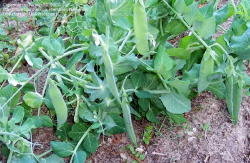
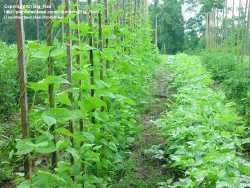
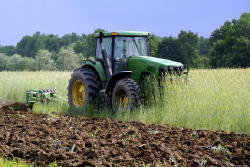 Peas Bean rows
Peas Bean rowsPlants need nitrogen to make amino acids, the building blocks of proteins, and nitrogen is essential for making chlorophyll. Chlorophyll is the molecule that converts sunlight (energy) into carbohydrates by the process of photosynthesis. Nitrogen makes up 78% of our atmosphere, as N2, an inert gas. Plants cannot use this nitrogen without microbes first converting it… or “fixing” nitrogen. This is only done in the root zone of a plant. “Legumes release compounds called flavonoids from their roots, which trigger the production of nod factors by the bacteria.”[1] We call this relationship symbiotic... the legumes release flavonoids for the bacteria, and the bacteria convert nitrogen so the plants can use it.
In a nutshell, what the Rhizobium bacteria does is stimulate the legume roots to grow nodules that “fix” nitrogen. (Nitrogen is the “N” in N-P-K fertilizers.) What “fixing” means is that the nodules absorb nitrogen from the air and convert it into ammonia in a useable form (NH3) that the plants can readily take up for growth. This fixing action has a two-fold effect. The first is making nitrogen available for the current crop. The second is when the plants are tilled under after the harvest. The nodules then provide a storehouse of nitrogen in the soil that becomes available for the next crop.
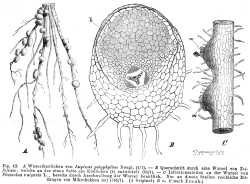
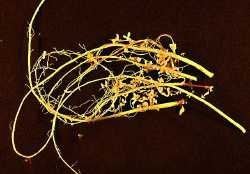
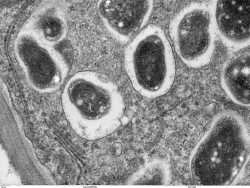 Nodules L-R: Lupine, Clover, Bean
Nodules L-R: Lupine, Clover, BeanThe microbes in the soil will generally live and thrive as long as they have available food. That means incorporating green matter and compost back into the soil, continuously. One reason some seasoned gardeners do not add inoculants is because they have a good supply of Rhizobium already in the soil, and keep it alive by feeding it. (There is a lot of nitrogen in organic matter.) Another reason is the benefits of inoculation are not readily visible by home gardeners. We seldom plant inoculated seed side by side with non-inoculated seed to compare harvest amounts, and we don't measure nitrogen in the soil.
Last year I grew beans for the first time, and did not use an inoculant. I had a bumper crop of beans so I know you do not need an inoculant to grow beans or peas. An inoculant will just make nitrogen more readily available to the plants, producing sturdier plants with a more vigorous growth and subsequent crop, increase pathogen resistance and increase the nitrogen in the soil for subsequent plantings after the spent crop residue is tilled under. Unfortunately, I did not till under my spent plants, so I missed out on adding available nitrogen back into the soil for this year’s vegetables. Note that some (not all) legumes use a LOT of the nitrogen fixed by the nodules, so using inoculants every year and tilling under green matter as often as you can may be an inexpensive way to keep nitrogen in the soil. My small 6 ounce bag will inoculate 50 pounds of pea or bean seed! Unless you plan to grow that many beans and peas, buy a small bag and share it... my label says use by the end of this current year.
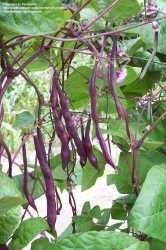
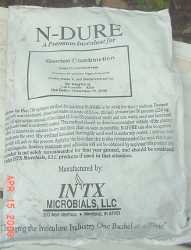
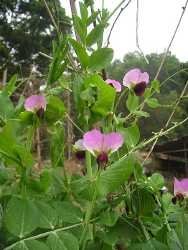 Phaseolus vulgaris
Phaseolus vulgaris I could have sequestered the nitrogen my beans held in their root nodules, in much the same way we can sequester carbon from the atmosphere by adding inoculated biochar to the garden soil. I inoculate my biochar with fresh human urine, which contains low amounts of organic urea that becomes ammonium in the soil. Then I add the small biochar pieces to my garden soil and either till it in, or cover with a layer of dirt. The ammonium feeds the microbial population, who convert it to useable nitrogen for root growth, and give it the ability to be taken up systemically by plants and/or used by other soil organisms.
Adding mycorrhizal fungi is also “inoculating”, but not just to fix nitrogen. These fungi attach to plant roots to aid in assimilating water and nutrients. Mycorrizial fungi could be a combination of endomycorrizal fungi like glomus intraradices, G. mosseae, and G. aggregatum. I am not too familiar with mycorrhizal fungi, so please see LariAnn Garner’s articles: Mycorrhizae - Optimizing the roots of your plants, Plant Growth Hormones, and Using microbes in concert to protect against pathogens.
Other reasons to use inoculants include reducing the amount (and thus cost) of fertilizers. There is documentation that inoculated legume (commercial) crops have increased yields, so I expect a greater harvest from my inoculated peas and beans as well. Another benefit is that inoculants act as protective organisms against plant pathogens. You can visually check to see nodule growth by digging up a mature plant and looking at the roots. (Rinse them if necessary.) Nodules that are effectively fixing nitrogen are pink or red; white nodules are doing nothing. Soft, green nodules have done their work and are no longer contributing.
Most garden supply centers sell inoculants specifically formulated for individual legume crops such as peas and dry beans, oats, alfalfa/clover, crown vetch, soybeans, peanuts and lespedeza. Each legume species requires a specific species and strain of rhizobia. The rhizobial species that nodulates alfalfa will not nodulate dry beans [2] so if you decide to use an inoculant, please be sure to purchase the correctly labeled inoculum for what you are planting.
End Notes:
[1] http://en.wikipedia.org/wiki/Root_nodules
[2] http://www.ext.colostate.edu/Pubs/crops/00305.html
Photo credits:
Farmerdill: peas growing, and Snap Bean Phaseolus vulgaris 'Blue Peter'
Tilling in rye for green manure: iStockPhoto # 3539760, Used by Permission
Big Red: Rows of beans
Soybean root nodules: public domain (Soybean root nodules, containing billions of Rhizobium bacteria)
Soybean Root-nodule cross-section: public domain
Peas in pods: licensed under the Creative Commons Attribution 3.0 Unported License.
Snow Pea flowers: This file is licensed under the Creative Commons Attribution-ShareAlike license versions 2.5, 2.0, and 1.0
Root nodules L-R Lupinus polyphyllus; Trifolium sp.; Phaseolus vulgaris: public domain
Inoculant package photo is by the author
Copyright © www.100flowers.win Botanic Garden All Rights Reserved